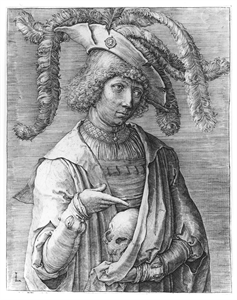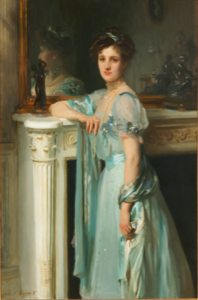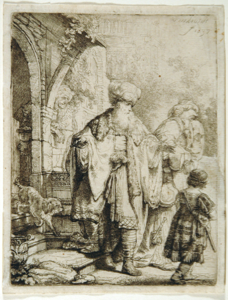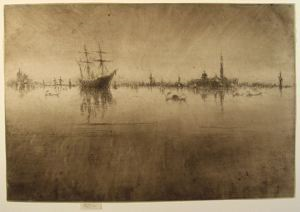
James Abbott McNeill Whistler
American, 1834–1903
From the series, Twelve Etchings (First Venice Set) 1881
During the etching revival at the end of the nineteenth century, some of Whistler’s contemporaries used plate tone (that is, ink which was left on the plate for printing to impart tone) with such enthusiasm that a controversy arose between printmakers who sought painterly effects and those who felt that etching should depend more on pure line: those in the latter camp sometimes disdainfully referred to plate tone as “sauce hollandaise.” Whistler, however, felt free to experiment with the inking of his plates, making dramatic changes in the time of day, focal point, and mood of his landscapes as he changed the wiping of the plate. Like Rembrandt, he also continued to make adjustments to the plate itself after the initial work was finished; "Nocture," for instance, exists in five states. The veils of ink used for this impression of “Nocturne” were designed to unify this composition of buildings as seen across the basin of San Marco in Venice. The composition is focused on the far bank, with the church of Santa Maria della Salute providing the most recognizable profile. Whistler purposely left the etched lines defining the foreground vague; he wiped the plate to give a sense of depth and atmosphere to the water and sky.
See "Dürer, Rembrandt, and Beyond from the Collection of Mr. and Mrs. Adolph Weil, Jr.," exh. cat. (Montgomery: Montgomery Museum of Fine Arts, 1994,) 14, and "Fleeting Impressions: Prints by James McNeill Whistler,” exh. cat., (Montgmery, AL: Montgomery Museum of Fine Arts, 2006), 49.
American, 1834–1903
Nocturne
1879–1880From the series, Twelve Etchings (First Venice Set) 1881
Object Type:
Print
Creation Place:
North America, American
Dimensions:
8 in. x 11 11/16 in. (20.32 cm x 29.69 cm)
Medium and Support:
Etching and drypoint on laid paper
Accession Number:
1999.0007.0135
Credit Line:
Gift of Jean K. Weil in memory of Adolph "Bucks" Weil, Jr.
During the etching revival at the end of the nineteenth century, some of Whistler’s contemporaries used plate tone (that is, ink which was left on the plate for printing to impart tone) with such enthusiasm that a controversy arose between printmakers who sought painterly effects and those who felt that etching should depend more on pure line: those in the latter camp sometimes disdainfully referred to plate tone as “sauce hollandaise.” Whistler, however, felt free to experiment with the inking of his plates, making dramatic changes in the time of day, focal point, and mood of his landscapes as he changed the wiping of the plate. Like Rembrandt, he also continued to make adjustments to the plate itself after the initial work was finished; "Nocture," for instance, exists in five states. The veils of ink used for this impression of “Nocturne” were designed to unify this composition of buildings as seen across the basin of San Marco in Venice. The composition is focused on the far bank, with the church of Santa Maria della Salute providing the most recognizable profile. Whistler purposely left the etched lines defining the foreground vague; he wiped the plate to give a sense of depth and atmosphere to the water and sky.
See "Dürer, Rembrandt, and Beyond from the Collection of Mr. and Mrs. Adolph Weil, Jr.," exh. cat. (Montgomery: Montgomery Museum of Fine Arts, 1994,) 14, and "Fleeting Impressions: Prints by James McNeill Whistler,” exh. cat., (Montgmery, AL: Montgomery Museum of Fine Arts, 2006), 49.
Keywords
Click a term to view the records with the same keyword
Related Objects
Click a record to view

The Beggars
1992.0002.0011

The Mast
1992.0002.0012

Wheelwright
1992.0002.0013

Little Venice
1999.0007.0134

The Little Mast
1999.0007.0136

The Doorway
1999.0007.0137

The Piazzetta
1999.0007.0138
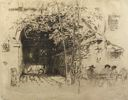
The Traghetto, No. 2
1999.0007.0139

The Riva, No. 1
1999.0007.0140

Two Doorways
1999.0007.0141

San Biagio
1999.0007.0142

Nocturne: Palaces
1999.0007.0143

Long Lagoon
1999.0007.0144

The Riva, No. 2
1999.0007.0145

The Balcony
1999.0007.0146
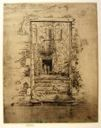
Garden
1999.0007.0147

Long Venice
1999.0007.0148
Portfolio List
Click a portfolio name to view all the objects in that portfolio
This object is a member of the following portfolios:
Your current search criteria is: Keyword is "SP" and [Object]Century is "Nineteenth Century".
